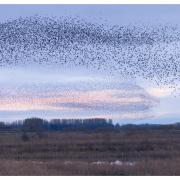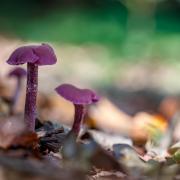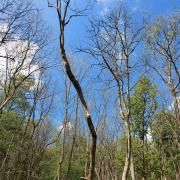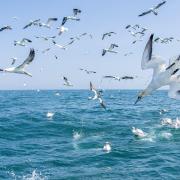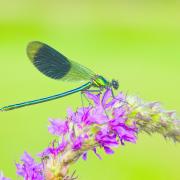Yorkshire’s wild orchids pack a suprising array of colour and clever techniques for living life in the undergrowth. Yorkshire Wildlife Trust’s Tom Marshall discovers more.

You’re running late. The florists are closed and despite the best efforts you still forgot to pick up a birthday present. So a mad dash into the petrol station supermarket gives you a choice; a box of chocolates or a stunning orchid nestling in a pot – who doesn’t love those purple petals ready to whisk you away to sunnier climes of lush green rainforests? It’s an easy choice so out comes the credit card.
Although these go-to exotic wonders might be the perfect back-up gift, it’s perhaps surprising to know Yorkshire has its own wide array of orchids – with enough to cover every birthday, anniversary and special occasion for even the most forgetful of us.
In fact, close to two dozen orchid species make a home in the county – around half of all found in the UK, from the diminutive and easily-overlooked, to the real show-offs of the orchid world.

The season begins as soon as Easter is upon us, going right through to late summer and providing a welcome splash of colour from the perilous cliff tops of the coast, to urban roadsides and the vast limestone pavements of our uplands.
Like all the best wildlife, the orchid family have been rather helpfully named – from those kicking-off the season like the early purple orchid, to the burnt-tip orchid looking like an unfortunate kitchen accident, or the helpfully labelled fragrant orchid.
Although purple predominates among this floral bonanza, yellows, reds and in some cases a veritable rainbow creates a delicate palette on offer for those willing to get down on their hands and knees for a close encounter.
During April and May, green-winged orchids with their sparsely spread and bulbous blooms dive up through our lowland meadows. Competing to be first to the starting line are the aptly-named early purple orchids, which can appear in stunning carpets at spots like Yorkshire Wildlife Trust’s Flamborough Cliffs, just metres from the high-rise residence of thousands of seabirds.
With a more subtle pink hue, pyramidal orchids are easily distinguished just as you’d expect, their conical flower heads forming the most attractive of shapes in sunny, free-draining chalk slopes and hillsides.
As the longer days of May and June arrive in the calendar, so do our bees – providing just the pollination courier service that bee orchids are after. With just a handful of striking pink, yellow and red flowers on a stout bright green stem, these tiny treasures are well worth a closer inspection – especially when they can appear in the most unlikely of rough and tumble locations from old building sites to roadside verges just minutes from the centre of York at Askham Bog. Such subterfuge is clear to see, with the flower heads an almost perfect match to entice a visiting bumblebee.
Another fan of bees are the burnt-tip orchids which have a rich purple tip to a set of white and delicately spotted blooms. Likely to be found with a supporting cast on sunny slopes in the North York Moors and Yorkshire Dales, burnt tips are often alongside the rather more ubiquitous common spotted orchid, standing proud with a spike of densely-packed pink flowers.
Easily missed is the lesser butterfly orchid, another member of the family where less is more and fragile creamy-white flowers scatter nonchalantly atop a stem, less packed than its neighbours. As June becomes July, the fragrant orchid arrives with its pale pink flower heads and citrusy aroma, best experienced during the evening.
Keeping up the insect-based deception is the fly orchid, and although one of the seemingly less glamorous species, there’s no denying its ability when comes to setting the stage of illusion – set high amongst two-foot high stems. Another late bloomer in July and August is the frog orchid, lacking the rather dour colours of its namesake in favour of a subtle range of mauve and pale reds, on prominent rugby ball-shaped flowers.
Perhaps most famous among the Yorkshire orchids however, and laying claim to the most delightful name of all is the exquisite lady’s slipper orchid. Once a feature of our limestone uplands in centuries past, there are even records of bunches being sold in local Yorkshire markets in the late 18th century. With such desirability, it’s perhaps no surprise that along with changes in agricultural practices and the habitats upon which they relied, today it remains one of Britain’s rarest wild plants and has even been subject to police protection in recent years.
Thanks to a propagation scheme at Kew Gardens and a selection of highly secret sites in the county, it is slowly making a comeback and those wanting to make the pilgrimage to see the blooms – which can take 10 years to come to fruition – can do so at a local farm in Wharfedale.
So although Yorkshire’s own hint of the tropics will never grace a vase or one of those pots at the petrol station – protected as they are like all wildflowers by law – for those lucky enough to spot one, a Yorkshire orchid encounter is surely the best summer gift.
Where to look out for orchids
Yorkshire Wildlife Trust sites at Ashes Pasture, LA6 3JF; Brockadale, Pontefract, WF8 3LJ; Flamborough Cliffs (North Landing) YO15 1BJ; Leyburn Old Glebe, YO62 5LE; Wharram Quarry, YO17 9TW and Kilnsey Park Estate, Skipton, BD23 5PS.
Ashes to ashes?
This summer, Yorkshire Wildlife Trust has been given a unique opportunity to safeguard one of Yorkshire’s last endangered wildflower meadows – and orchid hotspots. Ashes Pasture in Ribblesdale sits in the shadow of Pen-y-Ghent, and along with a stunning array of flora, is also home to the rare black grouse and other upland birds.
Now, the Trust urgently needs to raise £39,000 to finally secure this piece of valuable habitat, to avoid it be lost again and potentially sold on the open market – leaving an uncertain future for the wildlife making a home there.
Every contribution will help, and those donations over £100 will also be acknowledged on the site itself. Please visit www.ywt.org.uk or call 01904 659570 to see what you can do.












